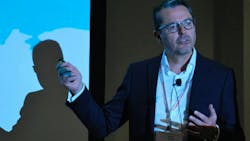Standardization to accelerate green hydrogen growth
If your green hydrogen plant is all dressed up, it better have someplace to go.
This classic dilemma for would-be partygoers applies equally well to all the green hydrogen and related, low-carbon, renewable energy projects being developed in Europe and elsewhere. It’s not enough to design and build an innovative, efficient process with transformers and rectifiers, electrolyzers, and H2, and O2 separators. The hydrogen it produces must have a readily available supply chain, including an established distribution network and customers ready to consume it, or the whole project won’t be able to secure the financing it requires and will likely collapse.
“The energy transition is here. Green hydrogen projects started accelerating in Europe during the early days of the COVID-19 pandemic, and they’re being done by users with diverse work experiences in refineries, utilities and elsewhere, which also have a range of capacities in diverse locations,” said Greg Stock, director of the Green Hydrogen Center of Excellence at engineering firm Worley. All of them can influence how green hydrogen can work.”
Stock presented “Standardizing green hydrogen assets—a supply chain-led solution” this week at the 2024 Honeywell Users Group in Madrid.
Barriers hindering hydrogen
Stock reported that research by Bloomberg NEF shows planned or announced hydrogen projects in Europe are expected to climb from 0.4 million metric tons of capacity per year in 2024 to 41.8 million metric tons of capacity per year during 2031-50. However, only 7% of these projects have obtained financing and permits, which means the vast majority are merely planned or announced and must still pass the financing investment decision (FID) stage.
“This research shows a nice, upward curve, but so far, hydrogen production projections don’t address what’s going on in reality,” explained Stock.
Low-carbon hydrogen efforts are enabled by continuing R&D, grants and subsidies, growing technical know-how, and legislation and decarbonization targets. However, they’re held back by several formidable barriers, including the need for offtake agreements, large-scale renewable production and transport, H2 and CO2 transport infrastructure, and grid carbon intensity.
“Offtake agreements are important because hydrogen producers must have someone to sell to at an established price, so they can secure financing for the capital expenditures (CapEx) needed for their production plants and related projects,” explained Stock. “For instance, there are many existing hydrogen pipelines, but many more backbone pipelines are needed, and hydrogen plants also need stable water and electricity sources.”
Partners and prices
To help green hydrogen projects progress, and contribute to meeting 2030-50 net-zero emissions targets, Worley has released a think-tank study detailing five major changes that can help projects meet their FID challenges. They include:
- Broadening value demonstrated to shareholders, local communities, environment and cultures.
- Technical enabling options, which include the four primary methods of producing hydrogen, and the 20-30 best-known suppliers who manufacture it.
- Standardization on the most effective green hydrogen production methods, so they can be reproduced and quickly scaled up.
- Creating partnerships with everyone who can help implement low-carbon hydrogen commercialization, including production plants, pipelines, offtake participants and other players.
- Digital acceleration as practiced by Worley’s asset optimization center, which takes input from design and optimization sources, and develops a template for a plant that can produce hydrogen at the lowest cost.
“Hydrogen used to be made and transported by all kinds of different companies that weren’t used to working with each other, which can slow down today’s low-carbon projects,” added Stock. “We need partnerships to speed up these efforts.”
To reduce the levelized cost of hydrogen, Stock reported that it’s important to think less about numerical prices, and more about modular products that a green-hydrogen plant can produce. This consists of:
- Adopting a modular design approach that simplifies optioneering and accelerates engineering to deliver a standardized design that’s focused on fabrication.
- A connected, supply chain-enabled solution, including fabrication, delivery and installation, and accelerated asset-delivery timelines that is focused on operations.
- Asset optimization and a data-driven approach that results in a connected asset with smart operations functionality and is focused on efficiency.
Standardized supply chain saves scheduling
Stock emphasized success in the green-hydrogen game depends on using common, modular building blocks to construct a standardized plant that can be scaled from 100-megawatts (MW) up to more than 1 gigawatt (GW). For example, the usual transformers and rectifiers, electrolyzers, and H2, and O2 separators at the center are supported by a kV substation, pure water supply, potassium hydroxide (KOH) system, automation and controls, and purification and custody metering before transport. The balance of plant (BoP) consists of building design services, civil engineering work, nitrogen system, HVAC, instrument air, pipe racks, cooling system and H2 and O2 venting.
The total installed cost of Worley’s package usually consists of about 33% each for the electrolyzers, BoP and site assembly. More specifically, the electrolyzers include their production stack infrastructure, OEM contracts, and Worley and source components. The master service agreement (MSA) for the BoP covers HVAC, preassembled racks, hydrogen purification unit, compression system and cooling water system.
“Balancing the electrolyzers with the BoP makes the whole project more predictable and helps derisk it,” said Stock. “This also helps us employ our partnership model, which includes zippered, proactive collaboration, shared intelligence, co-created design, aligned MSAs, and a proactive approach to project delivery. We can’t do projects like this in a purely transactional way any longer. Everyone has to step in and become part of the solution. It’s been eye-opening for us because we asked partners to bring in their basic aligned machine services agreements, which let us achieve more proactive project delivery.”
Likewise, developing a standardized, efficient supply chain strategy also creates scheduling advantages. “If a user can get a package that’s fully, supply chain-enabled, it will also be more predictable, and help them pass FID and secure financing in about half the time it usually takes,” added Stock. “Instead of nine to 12 months, they can now get to FID in four months or even less in the future.”
About the Author

Leaders relevant to this article:

